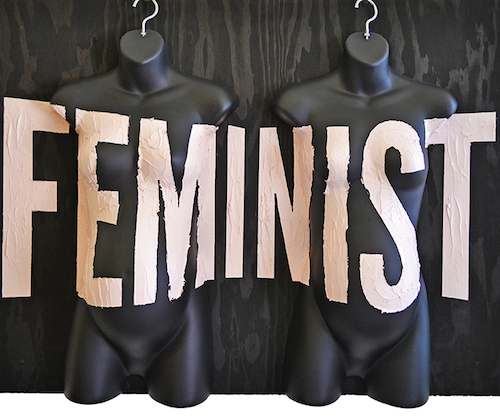
Beyoncé Inc. (S, M, L, XL), by April Bey. Oil on maternity mannequin and board, 36”X48”, 2014
This guest blog post comes in response to recent digital conversation sparked by an article on MTV.com taking issue with the description for an undergraduate Fine Art course (co-taught, not incidentally, by a woman of color) entitled “Pretty Hurts.” This piece, composed by Fine Art department chair Vanalyne Green and course instructors Ariel McCleese and April Bey, was intended to contribute to this vital and momentous exchange as well as to elucidate the intentions animating the description’s provocation. We hope the dialogue will continue as we wholeheartedly embrace the values of inclusivity and gender equality that have informed this conversation as well as the work of all the artists discussed below. Please continue to weigh in with your thoughts and ideas on this dynamically shifting terrain in the comments section below.
We enjoyed reading the piece about Fine Art’s “Pretty Hurts course” and want to provide a context and a different point of view about the material discussed.
The questions asked in the course description are meant to challenge students into understanding their roles as consumers of popular culture. Can we be critical of things (music, ideas, etc.) we like? Can we be critical of ourselves? If something is popular is it automatically right? We purposefully made the course description enticing to students willing to tackle these questions by taking this course.
Using popular culture icons such as Beyoncé and Jay-Z enables us to communicate ideas and images that span the gap between cultures. Students today may not know the important work of artist Judy Chicago or Womanhouse; but they certainly have something to say about Beyoncé, popular feminist blogs such as Jezebel and other icons within the cultural arena. Through this lens, using pop culture and the process of consuming that pop culture we expect students to formulate their own positions after taking this course.
The course description of “Pretty Hurts” is, in fact, a strategic component of the class itself. Its intent is to provoke a critical response, to be challenging and incite debate. The faculty did not write the description with certainties, but with questions meant to promote discussion. This course represents a significantly new direction in the Fine Art department. But it’s also worth noting that in spite of Beyoncé’s worldwide popularity we could find no other class in any arts education program that addresses this historical moment in music, feminism, and visual culture.
In one of Jay-Z’s most popular songs “Big Pimpin” he sings about being, “A pimp in every sense of the word.” Although he later said he regretted the words, Jay-Z’s self-identification with being a pimp is undeniably a part of pop culture. The aim of this course is to analyze how artists, Jay-Z included, define themselves and their work.
Beyoncé’s recent use of the word feminism has been written about and challenged extensively. From Annie Lennox to myriad other singers, feminists, journalists — that’s what makes the discussion so interesting. The course takes on pop culture and feminism, but from within the language of pop culture itself – as an opportunity to consider the debates about sexism, racism and gender.









Seeing how Feminism is the advocacy of women’s RIGHTS on the grounds of political, SOCIAL, and economic equality, I cannot see how this course advocates for Feminism by calling out the rights of another woman and bashing her for the way she chooses to represent herself. I found it incredibly disrespectful and in fact irresponsible to use such an overt and biased opinion to provoke an audience for this discussion. As an Art Center student this course description does not represent me or my position on Feminism. And also as an Art Center student I am in fact fully aware of the influence of Judy Chicago and The Womanhouse on Feminism. I would argue that through their exploration of the female experience, the female body, and sexuality that they further liberated women and brought the idea of a woman’s right to her own sexuality to the forefront of the feminist conversation. So I guess what I fail to recognize in the reference to Judy Chicago and The Womanhouse is the connection to the position this class has taken by shaming another woman for expressing her sexuality, and seeking empowerment through her sexuality. In the attempt to “wholeheartedly embrace the values of inclusivity and gender equality” I found this course description to actually be incredibly divisive, alienating, and kind of hateful. This approach to Feminism is damaging and counter productive, pitting more women against each other for how they choose to carry themselves or their bodies needs to stop. There are much bigger conversations to be had, for example the course description for this class could have read, “How is it Eminem can still rap about raping and punching women in the face, but we’re upset at Beyonce for calling herself a Feminist?”